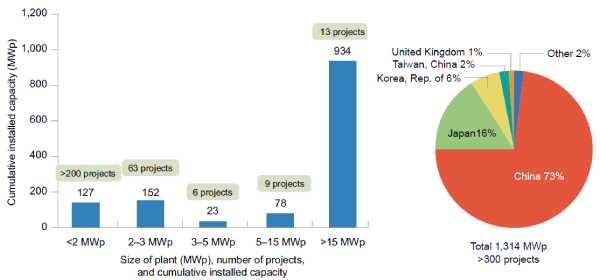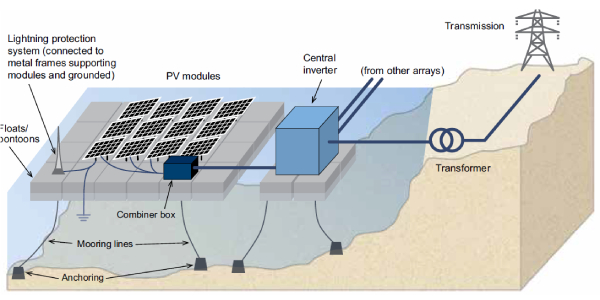Energy, Environment and Sustainability Group
At the end of 2018, floating solar PV (FPV) installations reached 1.3GWp, as detailed in Figure 1 below. The key benefits of increased energy yield and reduced evaporation, combined with declining costs of PV panels, means that rates are set to increase. The World Bank estimates a global potential of 400GWp under conservative assumptions.

Figure 1 Global installed capacity figures (source: World Bank)
As can be seen in Figure 1, 73% of current installed capacity is in China, 16% in Japan, 6% in the Republic of Korea, 2% in Taiwan and 1% in the UK, with approximately a third coming from 13 projects > 15MWp, though the majority of projects (>200) are less than 2MWp. Clearly Asia is leading the way and rates of installation have increased dramatically, with annual global installed FPV capacity given in Table 1 below.

Looking at the UK, the first FPV installation in the UK was the Sheeplands Farm project (see references), which has an installed capacity of 200kWp, was installed by Floating Solar UK, and commissioned in 2014. Comparing to the total installed capacity of FPV in the year of installation (11MW), the project accounted for 2% of the global installed capacity – quite a claim for a 200kW project!
Solar PV panels have been reducing in cost dramatically for some time, which has led to a rapid increase in installation rates across the globe. Indeed, the International Energy Agency forecast that solar PV will be contribute the greatest amount of electrical MWs globally in their World Energy Outlook, forecasting in excess of 3,000GW of solar PV by 2040, compared to approximately 750GW of installed capacity today. If all the 400GWp of FPV predicted by the World Bank is realised, this could mean that around 13% of global PV could be floating.
FPV uses the same core technology as conventional PV installations. However, it carries some obviously unique aspects, notably, floating pontoons and anchors, neither of which are new in their own right. Hence none of the technology employed is new, though the combination of technologies is still somewhat novel in most parts of the world. Installation could either be in salt-water or fresh water, though the latter would offer far less corrosion issues. A typical configuration for a large scale FPV array is shown in Figure 2 below.

Benefits of Floating Solar PV
One of the main benefits of FPV is reduced evaporation, meaning that more water is conserved and hence reservoirs become more efficient storage mediums. In parts of the world where water may be scarce, this reduced evaporation may be particularly valuable.
A compounding benefit in the case of hydropower is that the reduced evaporation allows reservoirs to be kept at higher operating levels, increasing the gross head and thereby reducing the amount of water required for a given MW output, hence a higher capacity factor for hydropower, as well as offering more reliable energy in drier seasons.
No additional land being required is also positive. This may be of increasing importance, as populations slowly increase and land hence becomes ever more valuable, areas that would otherwise be very good for solar PV may be better put to other uses, such as agriculture or housing.
Closing Thoughts
It is clear that there is great potential for FPV globally as it has a number of strong merits. FPV could be installed on new reservoirs as well as retrofitted to existing ones, with extremely fast installation times. Reduced evaporation rate is a significant benefit, and when combined with hydropower, this has a compounding positive effect of improving the capacity factor of the hydropower and reducing seasonal variation in reservoirs levels. Together with declining costs of PV panels, FPV is likely to play an increasing role in the global energy mix as part of a decarbonised electrical system.
Useful References
- https://www.worldbank.org/en/topic/energy/publication/where-sun-meets-water
- Floating Solar UK: http://www.floatingsolarpanels.co.uk/
- Sheeplands Farm, 200kWp: https://youtu.be/35CVojgRgfs
- https://www.iea.org/reports/world-energy-outlook-2019